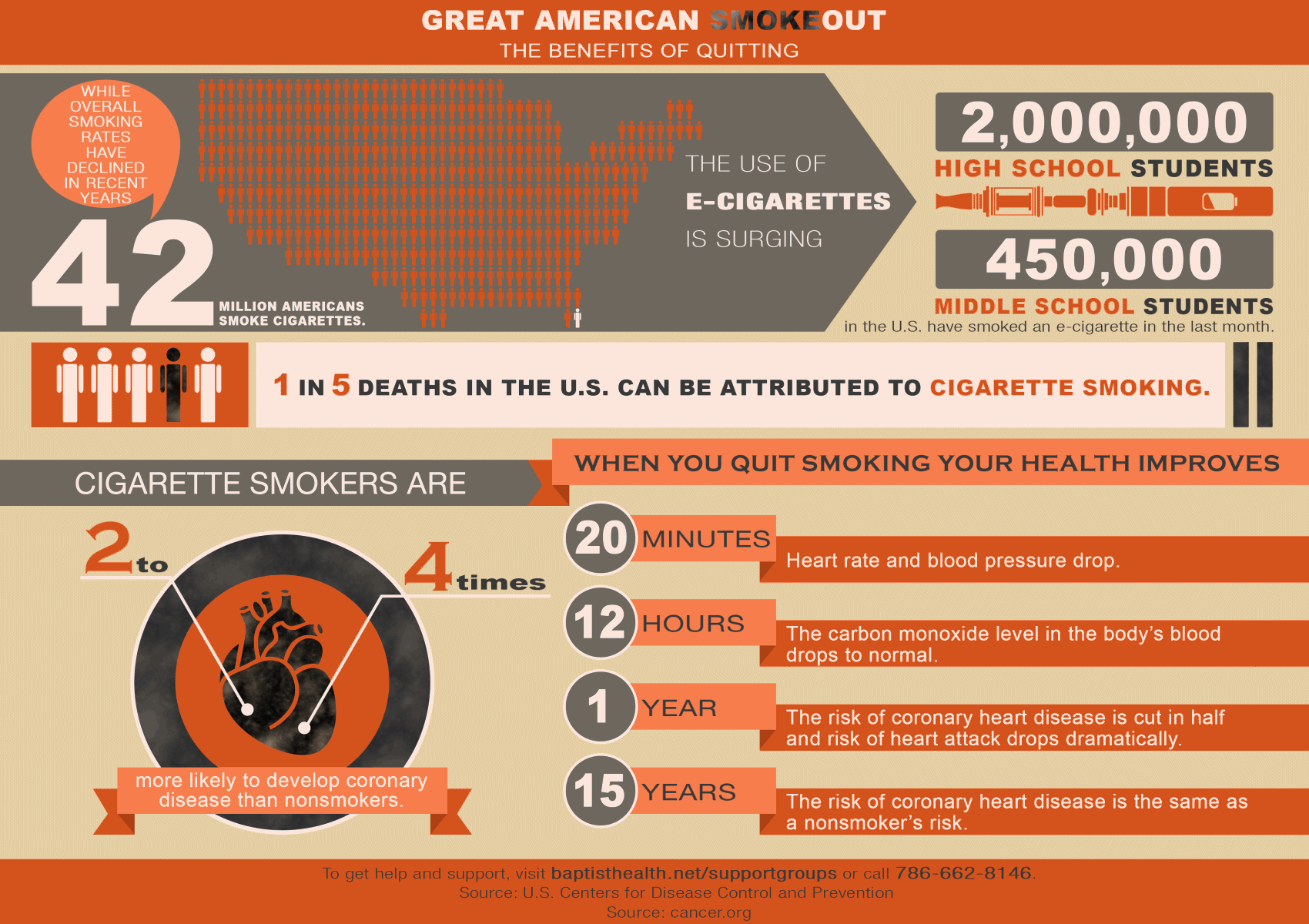April 7, 2020 by John Fernandez
Smokeout: The Many Benefits of Quitting Now (Video & Infographic)

Quitting the use of tobacco at any age can reduce the risk of getting or dying from cancer, or developing heart disease. Yet, smoking remains the leading preventable cause of cancer and cancer deaths.
New data from the U.S. Centers for Disease Control and Prevention (CDC) show that 40 percent of cancers diagnosed in the U.S. may have a link to tobacco use. Smoking causes about 90 percent of male and 80 percent of female lung cancer deaths. But tobacco use is also linked to cancer of the liver, colon and rectum, oral cavity, esophagus, pharynx (throat), larynx (voice box), stomach, pancreas, bladder, kidney, and cervix, and acute myeloid leukemia.
Today marks the American Cancer Society’s 39th annual “Great American Smokeout,” which is held on the third Thursday of November each year. The event is meant to encourage more smokers to quit, even if it’s just for one day. The Smokeout’s primary goal is to help get smokers started on the road to quitting, which remains a significant challenge to those unable to quite the habit after years of lighting up.
(Watch now as Lester Carrodeguas, M.D., a family medicine physician with Baptist Health Primary Care, outlines the immediate and long-term benefits of quitting tobacco use. See infographic below.)
Smoking Rate Falling
There is encouraging news: Data released by the CDC shows that current cigarette smoking among U.S. adults declined from 20.9 percent in 2005 to 15.1 percent in 2015. That’s the lowest prevalence of adult cigarette smoking since the CDC began tracking tobacco use in 1965.
Nicotine is addictive and that makes quitting tobacco extremely difficult, especially after years of dependency, says said Patricia Feito-Fernandez, M.D., primary care physician with Baptist Health Primary Care. The decision to quit must genuinely come from the smoker, and he or she must be firmly committed, according to primary care physicians and the American Cancer Society.
“I like to educate patients who smoke about tobacco’s affect on the body, not just the lungs and heart,” Dr. Feito says. “Not everyone’s lifestyle is the same, and for some people tobacco cessation is more difficult. After the appropriate education, counseling and support is in place, the decision to quit tobacco must come from the patient. I will help with a game plan once they make the decision to quit.”

(Infographic by Irina de Souza)
The Immediate and Long-Term Benefits of Quitting
The impact of quitting cigarettes or other tobacco products on a smoker’s health can be immediate, with significantly diminished risks of developing heart disease and cancer in the long-term.
How does the average smoker’s body recover over time after quitting? The American Cancer Society says that after…
20 minutes:
Your heart rate and blood pressure start to drop.
12 hours:
The carbon monoxide level in your blood drops to normal.
2 weeks to 3 months:
Your circulation improves, while your lung function increases.
1 to 9 months:
Coughing and shortness of breath decrease. Your lungs start to regain normal functionality, increasing its ability to fight infection.
1 year:
The excess risk of coronary heart disease is half that of a continuing smoker’s.
5 years:
Risk of cancer of the mouth, throat, esophagus and bladder are cut in half. Cervical cancer risk falls to that of a non-smoker. Stroke risk can fall to that of a non-smoker after 2 to 5 years.
10 years:
The risk of dying from lung cancer is about half that of a person who is still smoking. The risk of cancer of the larynx (voice box) and pancreas decreases.
15 years:
The risk of coronary heart disease is that of a non-smoker’s.
top stories












There are no comments